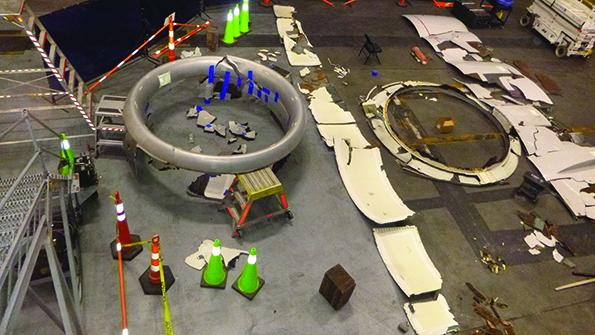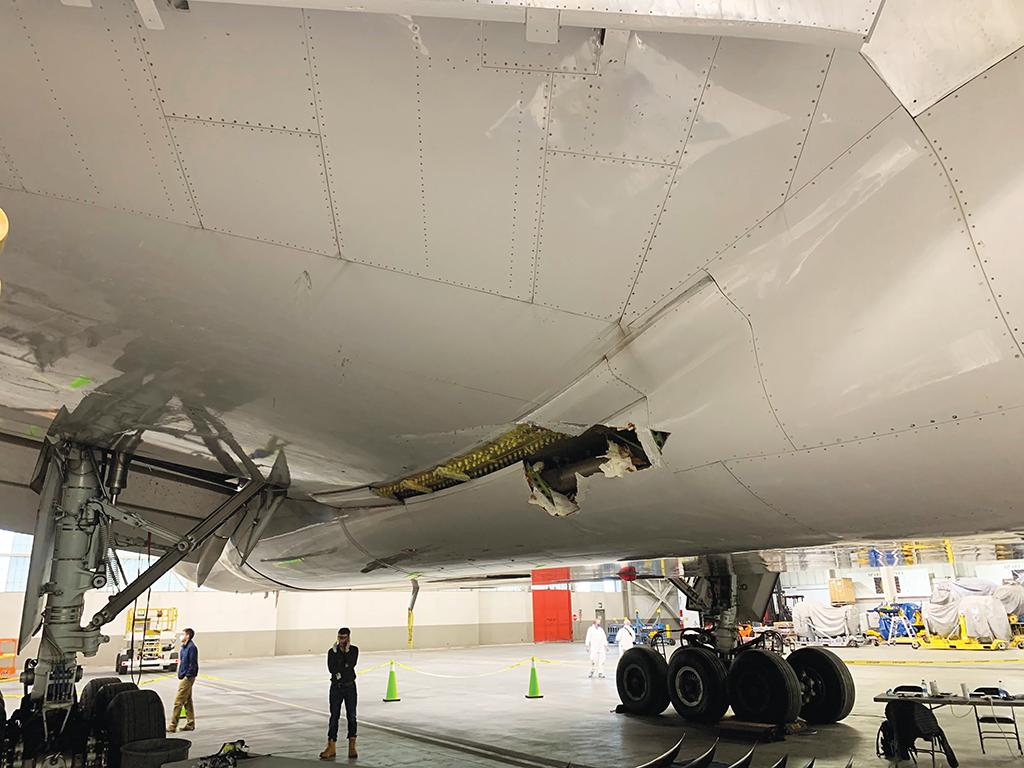
Details of Boeing’s planned design changes for nacelles paired with CFM56-7 and Pratt & Whitney PW4000-series engines include multiple structural modifications that the manufacturer suggests operators be permitted to phase in as they are approved, rather than testing the entire nacelle system at the same time, as FAA regulations require.
Documents filed with the FAA as part of a request to allow the phased implementation provide the most detailed descriptions yet of how Boeing plans to reinforce nacelles susceptible to damage when engine fan blades fail on 737 Next-Generation (NG) and Pratt-powered 777 aircraft. The design problems were spotlighted in five in-service fan-blade-out (FBO) events—three involving PW4000-powered 777-200s and two affecting CFM56-7-powered 737-700s—in the last six years, and they are changing how industry views the risks of fan blade failures.
- Changes focus on ensuring parts do not break away following fan blade failures
- Initial design changes are planned to be rolled out next year
The proposed modifications alter designs developed and approved in the mid-1990s as part of certification of the 777-200 and 737-700, the first 737NG variant. The fan blade failures and related airframe damage underscored that the analysis done during certification did not capture all possible risks linked to fractured blades. Advances in analytical modeling in the nearly three decades since the 777-200 and 737-700 were certified have given manufacturers more capable tools for understanding how blade failures can affect surrounding structure (AW&ST March 22-April 4, p. 25).
In each of the two 737 incidents, cracked fan blades fractured, triggering a series of events that included parts of the inlet structure breaking away. In the second event, an April 2018 accident that led to an emergency landing in Philadelphia, parts of the fan cowl structure also broke off. Investigators determined that the blade struck the fan case and transmitted loads to a latch mechanism. Part of the latch broke away, struck a window and dislodged it, causing a rapid decompression and leading to a passenger fatality.
Boeing’s planned 737NG design changes, which the company will release in service bulletins, focus on fortifying parts of the nacelle to minimize risks of similar occurrences. One planned set of changes will call for “larger, more capable” fasteners securing the inlet aft bulkhead to a flange fitting, Boeing explains in the documents submitted to the FAA. New crushable spacers will reduce how much energy a broken fan blade can transmit to the inlet.
Another service bulletin will cover installing a redesigned radial restraint fitting, which connects the bottom of the fan cowl to the engine. The change seeks to “prevent fan blade impact energy from being introduced into the fan cowl structure during an FBO event,” Boeing says in its request to the FAA.
Boeing also is redesigning bolts used in a fan cowl hinge fitting “to ensure that the fan cowl support beam hinge does not experience a failure during an FBO event,” the company says.
A fourth change would introduce a redesigned primary exhaust nozzle. “During both of the [737] events, the primary exhaust nozzle buckled and experienced cracking to the extent that concerns were raised over the potential for portions of the nozzle to depart the airplane during a fan-blade-out event,” Boeing says.
The company anticipates finalizing the four sets of changes and releasing service bulletins in 2022. The FAA then would mandate the modifications, and global regulators would likely follow suit, starting the clock for operators to upgrade 6,300 affected aircraft in the global fleet.
Like the two 737 occurrences, the three PW4000-powered 777 failures—two involving United Airlines 777-200s and one involving a Japan Airlines 777-200—spotlighted a few of the same risks. In each incident, inlet and fan cowl parts broke away (AW&ST March 8-21, p. 24) . In the most recent event, a February 2021 United incident near Denver, “the airplane experienced loss of flammable fluid and core compartment fire,” Boeing says.
In response, Boeing says it is developing inlet modifications that “will include ballistic shielding, metallic reinforcement added to the composite aft bulkhead and reinforcement in the region of the inlet that interfaces with the fan cowl and fan cowl support beam.” The changes are designed to help “ensure nacelle retention” and “provide structural support for the fan cowl and fan cowl support beam for loads resulting from” a fan-blade failure, the airframer says.
Fan cowl modifications will be part of Boeing’s redesign package, but they are still being developed. Among the considerations: strengthening of the fan cowl support beam and either modifying or redesigning composite panels, Boeing says.

Pratt is developing enhancements to help protect against engine fires, including a flange separation, the Boeing petition adds.
As with the 737 changes, Boeing expects the 777 modifications to be mandated via FAA airworthiness directives.
One wrinkle with Boeing’s planned nacelle changes is that meeting applicable FAA regulations for FBO events requires showing that every part of a nacelle design complies. “Thus, a showing of compliance for any one part of the structure requires a showing for all, as all are affected by the change,” Boeing explains in its FAA request on the 777 changes. “A fully compliant design requires simultaneous certification of all changes.”
Boeing has asked the FAA to let operators phase in the design changes as they are approved, instead of waiting for all changes for each aircraft to be done and validated by the FAA.
“All planned design changes are required to show full compliance to the regulations listed” in its exemption request, Boeing says. “However, due to the complexity of changes required, not all design changes will be available simultaneously. . . . Without an exemption, this system-level showing could only be made after all of the design changes were available, which would delay the associated service bulletin and hardware kit availability dates. This delay would impact operator capability to plan for and achieve a systematic and nominal incorporation of each change in order to meet the anticipated mandated compliance period of the planned airworthiness directives.”
The FAA on Oct. 14 formally acknowledged receipt of the petitions and is reviewing them.
United and other operators are awaiting both the new inspection protocols and regulators’ decision on nacelle modifications to get affected 777s back in service after the 130-aircraft fleet was grounded following the February incident. United has the most aircraft affected, with 52, and has expressed its desire to keep them in its fleet. A few other operators, including Japan Airlines, accelerated planned retirements rather than wait for regulators, Boeing and Pratt.
In addition to the nacelle changes, Pratt has developed revised inspection procedures for the blades, including a new ultrasonic inspection that complements its proprietary thermal acoustic imaging process that has not been sufficient, sources with knowledge of the situation tell Aviation Week.





